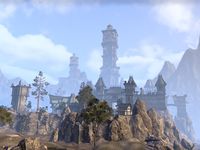Lore:Elinhir
| Elinhir | |
|---|---|
| Type | Settlement |
| Continent | Tamriel |
| Province | Hammerfell |
| Region | Craglorn |
| Demonym(s) | Elinhiran[1] |
| Appears in | Arena, ESO |

Elinhir, historically known as the "City of Mages", is a town in eastern Hammerfell, close to the border with both Skyrim and Cyrodiil. It is located in the Craglorn region, close to the Skyrim town of Falkreath. The city is noted for its massive Apex Towers of Nedic design. Elinhir reached its zenith in the Second Era, when it was considered the center of civilization in Craglorn. As of the Fourth Era, Elinhir was known for its use of magical techniques to make everyday tasks easier.[2]
History[edit]
Elinhir is the oldest surviving city in Craglorn. It was originally a Nede settlement, as evidenced by the city's tall Apex Towers. According to some legends, it was built by the "Nameless Founder" at the impact site of a great skystone that fell from the sky.[3] The Apex Stone of the Mage, a powerful remnant of the Nedic religion, is located beneath the city. The city was overseen by Governor Pomptinus from 1E 2820 to 1E 2852 as part of the Second Empire, during which time the city sewerworks were constructed.[4] Before the beginning of the Second Era, Elinhir was similar to the rest of Craglorn in that it was settled mainly by those unfit for life inside the Empire, and it was constantly preyed upon by bandits and Iron Orcs.
Early in the Second Era, a group of rogue mages led by Felix "Blackcaster" Augustus arrived at the city after departing from the Mages Guild and attempted to occupy the ruins of the Apex Tower. The mayor refused them, and in retaliation the mages seemingly made a deal with the Iron Orcs so that the latter would besiege the city. In a show of might, the mages drove the Orcs away, and subsequently signed the Apex Accord with the town's leadership. Under this agreement, the mages would protect the town for as long as the people of Elinhir provided support for the operation of their mages' academy.[5]
From these rogue mages grew the Blackcaster Mages Guild, who eventually came to rule over the city. Elinhir still served as a haven for outcasts, but was "civilized" under the strict rule of the mages. Despite being labeled as renegades by the Mages Guild, Elinhir prospered under the mages as their academy grew. Between 2E 546 and 2E 572, Elinhir was a cultural hub noted for its artists, artisans, and performers, and Prince Jorunn visited the city out of artistic and philosophical pursuits.[6] This prosperity changed in 2E 582, when the constellations fell from the skies above Craglorn. An agent of the Scaled Court made a deal with the mages, offering to unlock the true power of the Nedic devices in their towers in return for the location of the Mage's Apex Stone. The Serpent subsequently corrupted the Stone and gained control of the Mage, who caused chaos in the surrounding region. Atronach guardians, who had been summoned to protect Craglorn from Molag Bal's Dark Anchors, turned rogue, and people were transformed into mindless spellfiends by the massive amounts of magicka permeating the region.[7]
The Blackcaster mages were similarly corrupted when they attempted to cast the Nedic spell. The results were horrendous, and the Blackcasters began to hunt down every mage in Elinhir to steal their magicka, killing many civilians in the process. At their nearby complex of Balamath, the guild also created Air Monarchs from the rogue elementals in an attempt to assemble a Daedric army for the Serpent. The guild's leader, Arch-Mage Yamanu-ko, was driven insane by her lust for power, and Elinhir's surviving population were forced to flee or take refuge in the city sewers. The city's problems were ultimately resolved with the death of Yamanu-ko and the cleansing of the Mage's Apex Stone.[7]
According to an edition of the Pocket Guide to the Empire written in 2E 864, the Redguards of Elinhir had adopted Colovian fashion and taste.[8]
During the Imperial Simulacrum in the late Third Era, the city-state of Elinhir was an active settlement. At the time, it was known as the "Guardian of the West." It was ruled by Queen Fhimke-i, and it had a rivalry with Dragonstar.[9] Elinhir was neighbored by several settlements, including Nimbel Moor to the northwest, Stonedale to the south, and Falkreath to the northeast.[10][11] Elinhir was caught up in the War of Bend'r-mahk, having been claimed by the Nords of Skyrim. Although resistance in Elinhir was feeble at best, there was much more conflict on the border regions in the countryside.[12] At around the same time, the High Prophet of Elinhir, Ayaan-si, assembled the True Crowns of the north and started a rebellion against King Lhotun and the Kingdom of Sentinel to the west. Ayaan-si's efforts had started to pay off when he managed to liberate Totambu from Sentinel.[13]
By 4E 201, butchers in Elinhir used magical techniques of crushing up ice wraith teeth to preserve meat for long periods. Marise Aravel referred to it as a small town near Skyrim's border.[2]
Notes[edit]
- The city is spelled "Blinhir" on the Elder Scrolls Anthology map, though this is likely a misspelling.[14]
- Arena was originally conceived as a fighting game featuring a tournament that took the player to each of Tamriel's cities to challenge different gladiatorial teams. According to a file from that stage of development left behind in the final game, Elinhir's gladiatorial team would have been called "the Blackcasters".[UOL 1] It was later reintroduced as the name of a group of mages in the city.
- During Saturalia, the youth of the gentry give each other licentious presents that are intended to dare the recipients into lascivious behavior, though the giver's name is never revealed—it's up to each recipient to guess who their 'Secret Sanguine' was.[15]
See Also[edit]
- For game-specific information, see the Arena and Elder Scrolls Online articles.
Books[edit]
- The Flourishing of Elinhir by Garold Farfly — The history of Elinhir and the establishment of the Blackcaster Mages Guild
References[edit]
- ^ Blackcaster Mage's Spellbook contraband item in ESO
- ^ a b Marise Aravel's dialogue in Skyrim
- ^ Periapt of Elinhir item description in ESO
- ^ ESO loading screens
- ^ The Flourishing of Elinhir — Garold Farfly
- ^ Jorunn the Skald-King — Helgreir Lute-Voice, Bard of Windhelm
- ^ a b Events of ESO
- ^ Pocket Guide to the Empire, 1st Edition: Hammerfell — Imperial Geographical Society, 2E 864
- ^ Elinhir location and rumors in Arena
- ^ Map of Hammerfell – The Elder Scrolls: Arena
- ^ Map of Skyrim – The Elder Scrolls: Arena
- ^ Pocket Guide to the Empire, 3rd Edition: The Throat of the World: Skyrim — Imperial Geographical Society, 3E 432
- ^ Pocket Guide to the Empire, 3rd Edition: The Ra Gada: Hammerfell — Imperial Geographical Society, 3E 432
- ^ The Elder Scrolls Anthology map
- ^ New Life Festival Interview — Countess Aurorelle Edrald, Marwig Yeomcroft, Priestess Phaziyya, and Mochtuinne Eye-Tooth
Note: The following references are considered to be unofficial sources. They are included to round off this article and may not be authoritative or conclusive.

